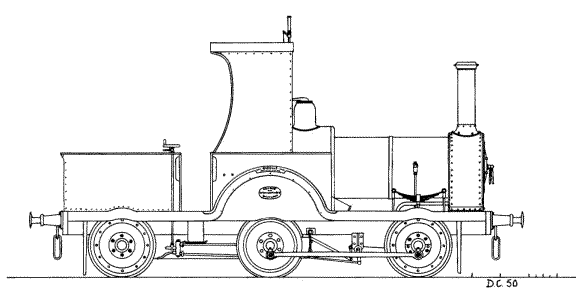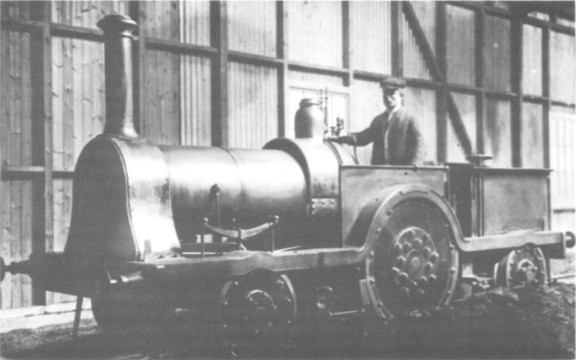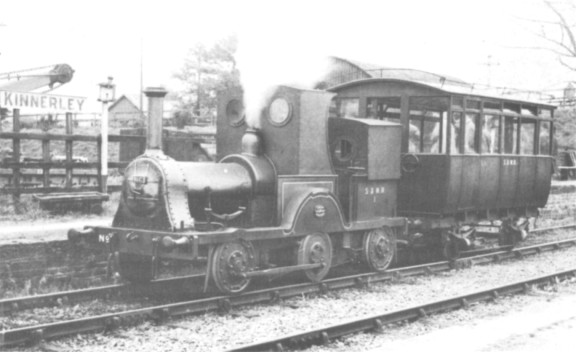
| THE INDUSTRIAL RAILWAY RECORD |
© APRIL 1969 |

GAZELLE
ERIC S. TONKS
In the operation of his light railways Colonel Stephens was never afraid to experiment in the never-ending search for means to reduce costs. Light construction and light loads meant light locomotives and the Colonel assembled from main line and industrial sources a wide variety of motive power with minimal axle loading and economical fuel consumption. In this category GAZELLE - an appropriate name if ever there was one - takes the cake without a shadow of doubt. She has been claimed to be the smallest standard gauge steam locomotive ever built and I know of no rivals. She really was an extraordinary machine and one cannot escape the feeling that the firm of Dodman, having been asked to produce a locomotive, chose for their model one of those wooden "puffers" that children used to drag along by a piece of string. Nevertheless, she worked, and worked well, as anyone who saw her storming up the bank out of Shrewsbury Abbey station will testify.
She was built in 1893 by A. Dodman & Co Ltd, Highgate Works, Kings Lynn, to the order of a Mr William Burkett for his private use. He was a businessman having, apparently, considerable influence with certain railway companies, and used the engine for local business trips mainly but on one occasion is known to have reached Chesterfield (Market Place) station. As built she was a 2−2−2 well tank; her cylinders were tiny (4in by 9in) and with her light-weight wooden wheels she turned the scales at only 5ton 6cwt. In 1910 she was offered for sale by Thos W Ward Ltd of Sheffield and Colonel Stephens purchased her, in February 1911, for use as an Engineer’s Inspection unit on the newly-formed Shropshire & Montgomeryshire Railway.

At Kinnerley in 1911 (Author's collection)

At Kinnerley on 23rd April 1939 - the BLC special (L. W. Perkins)
According to the book "Steam Engine Builders of Norfolk" (by R. H. Clark) her driving wheels were 3ft 9in diameter, other dimensions being wheelbase 10ft 6in, centreline of boiler 3ft 11in above rail level, height to top of chimney 7ft 9in, and length over buffers 17ft 2in. An unknown photographer recorded her at Kinnerley, in original condition, in 1911; a copy of the photograph is reproduced herewith, the gentleman on the footplate being the late Mr T. R. Perkins. Stephens soon decided that GAZELLE should be altered, and in July 1911 the well known loco building firm of W. G. Bagnall Ltd made some major alterations to her, which included the replacement of the driving wheels by a pair the same diameter (2ft 3in) as the others (and then coupling them to the leading pair making the loco a 0−4−2 well tank). Still not entirely satisfied, the Colonel returned her again to Bagnall in September 1911, when the cab and tender enclosure was added. In this guise GAZELLE entered its new phase of life, to be measured and drawn many years later by Doug Clayton, whose work is featured at the head of this article.
This is not the place to go into the involved history of the formation of the S & MR but in brief the latter sought to revive a railway, opened in 1866, that had lain derelict for some twenty years. This ran from Shrewsbury (Abbey) station to Llanymynech (between Welshpool and Oswestry) and there was a branch from Kinnerley Junction to Criggion at the foot of Breidden Hill. It was this branch that GAZELLE was rebuilt to serve and for nearly twenty years she handled the bulk of the branch passenger traffic, hauling a "coach" consisting of an old London County Council horse tramcar body mounted on flanged wheels. When the regular branch service ceased in Sep 1928, GAZELLE did some main line work but was soon afterwards withdrawn from service. She lay derelict beside the water tower at Kinnerley until 1936 by which time she was in a deplorable state, with most of her boiler casing and mountings missing. In that year, however, Mr W. H. Austen, who had succeeded the late Colonel Stephens, decided to return her to her original status of Inspection Car. She was taken into the repair shop, the missing pieces ferreted out from amongst the nettles, and in June 1937 she emerged resplendent in a livery of olive green, lined black and white, with red buffer beams and connecting rods, brown frames, green wheels, grey buffers and couplings, and with safety valves, dome and nameplates polished. She was lettered S & MR 1 in white on the cabsides.
The original tram body had rotted away beyond repair, but as the frames were all right the body off the Wolseley-Siddeley railcar set (or it may have been one from the West Sussex Railway) was fitted. The unit was then used for inspection trains and private parties. The latter was chartered locally at Bank Holidays mainly but on Sunday, 23rd April 1938, the Birmingham Locomotive Club ran what is believed to be the first-ever enthusiasts’ railtour over a minor railway in this country, using GAZELLE and her coach. Attendance was limited to twenty-two and an overflow tour took place the following week. It is almost impossible to convey adequately the pleasure of this delightful trip, which was unique and quite unrepeatable; but the lucky participants will remember it to the end of their days.
The War Department acquired the S & MR in 1941 for conversion into a military railway serving a series of ammunition storage sites, and introduced a large fleet of locos, mainly "Dean" 0−6−0’s at first. GAZELLE was found a job - to run over the main line before the first train left Kinnerley, to ensure that all points were correctly set and to counteract the efforts of possible saboteurs. She was repainted light green with black frames and red motion, and in this form outlived all the other S & M stock. Eventually her duty was allocated to a Wickham railcar and her last public showing was in 1945 in connection with a National Savings campaign. She was then stored at the end of a siding by the pond at Kinnerley, where she suffered some collision damage from a "Dean"; earlier she had lost the top of her chimney on a trip to Criggion and the remainder had been sawn off level and a crude lip riveted on.
It is thanks to the efforts of Mr C. H. Calder, M.B.E., the Operating Officer of the S & M that GAZELLE was allowed to survive. He was very fully aware of the great interest attaching to this machine on the various railtours over the revived railway, and when the time came for the WD to abandon the area and hand over the line to British Railways, arrangements were made for GAZELLE to be preserved at the Longmoor Military Railway (Hampshire). Nominally she was added to BR (Western Region) stock in April 1950, being presented the following month on permanent loan to the War Department for preservation. So at Longmoor GAZELLE remains, for the beholding of all interested in the steam locomotive. Nobody can look at her without wondering why such a locomotive should ever have been built, but to me it conjures up nostalgic memories of two of those red-letter days that all enthusiasts must treasure. I paid my first visit to Kinnerley on 18th May 1937 and instead of finding a decomposing relic in the bushes was treated to the sight of a tiny engine restored to life by the loving care of a handful of employees of a railway that could hardly afford the price of the paint. What a wonderful piece of "news" it was, thirty years ago! And then - on 23rd April 1938 - that unforgettable run over the grass grown track, to the astonishment of people at level crossings and fishermen on the Severn. One of the latter was very nearly decapitated!
If museum exhibits are meant to stir the imagination and the memory GAZELLE succeeds admirably.
For the record ....
The Chinese Engineering and Mining Company had opened their coal mines at Kai-Ping, eighty miles from Tientsin, with which it is now connected by rail. In those days there was no railway and the mines were eighteen miles from navigable waters. Moreover, a canal could only be carried to within seven miles of the mines. After much delay and governmental expense permission was granted by His Imperial Highness the Son of Heaven for the construction of a tramway from the mines to the head of the canal at Su-Ko-Chung. This tramway was to be operated by mules, ponies and Chinamen. No permission for the use of a locomotive could be obtained; consequently as none could be ordered from abroad the chief engineer decided to build one without permission and then prove to the Chinese its superiority over mules, etc. The object was not to build a first-class locomotive, but to build, at as slight a cost as possible, a locomotive that would serve as an object lesson.
The boiler was taken from an old English portable engine. The cylinders, 8in by 15½in, were from a winding engine. The driving wheels were of American chilled iron, 30in in diameter, and purchased as scrap. The frame and channel irons were taken from an old headgear of No.1 shaft. The wheelbase was 8ft 4in; the weight on drivers 6 tons. The engine had side tanks and end coal bunkers, one motion pump, one donkey pump and Stephenson’s link motion. The cost completed for labour and other than old material was about £110.
The locomotive was run for the first time on the centenary of the birth of George Stephenson, and very naturally was christened the ROCKET OF CHINA. On November 8th, 1881, the first trip over the main line was made, a run of seven miles and return, with two coal cars full of delighted officials. After that she made 12,000 miles, and is now a fixture in the railway shops, her only duty being to run a pump.
(This fascinating glimpse of a primitive industrial railway is culled from an undated cutting from an unknown source, mounted in a scrap book compiled by the late Mr. A. H. Lucas around the turn of the century. - courtesy W. A. Lucas.)